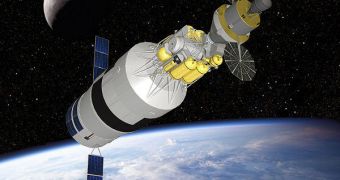Yesterday, the review panel that US President Barack Obama appointed earlier this year to analyze the activity at the American space agency NASA at last released the final version of its report, a 156-page document. The main conclusions of the analysis are that the space agency is severely underfunded for Project Constellation, and that NASA would be better off teaming with the private sector in its quest for space exploration. The commission was led by former Lockheed Martin CEO Norm Augustine, Space reports.
Over the summer, the ten-member panel has compiled a list of five potential avenues of development for NASA, and all of them have been summarized in the “Seeking a Human Spaceflight Program Worthy of a Great Nation” document. According to Augustine, it may be that those more than four years of work and $9 billion put into Project Constellation may have been spent uselessly, as the agency suffers from a severe lack of funding as far as the five components of the Project go. Without a $3-billion increase in funds until 2014, there is no chance for the new spacecraft to see action at the end of their respective deadlines.
The main reason for this financial discrepancy is the fact that, when NASA first envisioned this alternative to the space shuttles, back in 2004, and designated ARES I and the Orion Crew Exploration Vehicle as the main replacements for its aging shuttle fleet, it did so under budget predictions that did not come true in the end, leading to this situation. Even if additional funding was provided, the committee found, the five-year gap between the shuttle retirement and the introduction of the new vehicles was very likely to extend to at least a seven-year gap.
“It was right at the time, but times have changed,” Massachusetts Institute of Technology (MIT) Professor and committee member Edward Crawley says. He adds that NASA could undoubtedly overcome the technical difficulties associated with building ARES I at some point, but that it needs a lot of time and money for that, both of which are in short supply. “With time and sufficient funds, NASA could develop, build and fly the Ares I successfully. The question is, should it?” the report asks. “As we move from the complex, reusable shuttle back to a simpler, smaller capsule, it is appropriate to consider turning these transport services over to the commercial sector,” the committee writes.
Segments of the document also refer to the shuttle flying schedule, and to the involvement of the United States in the International Space Station (ISS). The station is currently scheduled to be deorbited in 2016, but the panel says that its life span could be increased to 2020. However, the funds required to fly the shuttles after 2010 and to attend to the ISS could, on the other hand, be used to fuel a more rapid advancement for Project Constellation. “The opportunity now exists to provide for the future human spaceflight program worthy of a great nation,” the report concludes.

 14 DAY TRIAL //
14 DAY TRIAL //